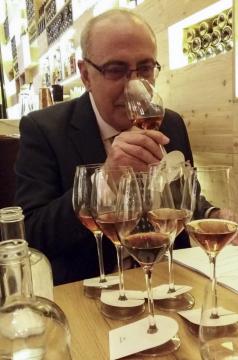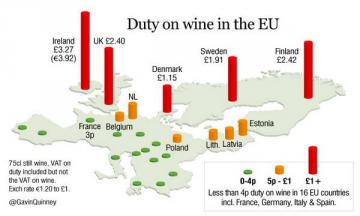The Sherry Conundrum
POSTED ON 22/03/2014Is sherry growing in popularity or is the much-vaunted sherry revolution a myth? This was the subject of a lively debate on Twitter recently after one journalist tweeted he was appearing on radio to talk about the growing popularity of sherry and another (ok, me) reluctantly questioned the assumption.
 Antonio Flores
Antonio Flores
I Say Syrah ...
POSTED ON 15/03/2014In the beginning there was syrah. Start again. In the beginning there was Bordeaux and Burgundy. Rhône barely registered across the palate until the American writer Robert Parker wrote a book extolling its virtues.
A Wine Odyssey
POSTED ON 08/03/2014Occasionally, but not that often, a wine tasting comes along that not appeals to the palate and the mind, but to the soul too. So it was with ‘The Voyage’, a wine tasting showcasing quality Mediterranean growers’ wines put on by the Theatre of Wine shops with importers Vino Nostro and Eclectic Wines.
Down the Escalator
POSTED ON 01/03/2014In the unparalleled choice of wines available to us, we wine drinkers in the UK have never had it so good. First there were the classics, then came the New World and Europe fought back with a step-change in quality from its outlying Mediterranean regions. Now there’s a new New World of wine lapping at our shores.
 Duty on wine in the EU
Duty on wine in the EU
Wines of the Long White Cloud
POSTED ON 15/02/2014Confessing a general immunity to the hype normally generated by wine PR, I have to admit that New Zealand is the exception that proves the rule. At last month’s overview of the 2013 vintage, I found myself full of admiration for this relatively small wine country, whose vineyard area covers a mere quarter of that occupied by Bordeaux. Small , of course, can be perfectly formed, and while perhaps not perfect, New Zealand’s compact size, in conjunction with its maritime climate and zest for wine quality wine, has seen it become the first and only wine country to break the £7 a bottle barrier.
Is Burgundy 2012 all it's cracked up to be?
POSTED ON 08/02/2014Considerable volumes of wishful thinking and even more hot air have been expended on the ‘wonderful’ 2012 Burgundy vintage, currently on offer. Sparing you the hyperbole and cutting to the chase, Burgundy 2012 is a good vintage in which a handful of great wines have been made by a few exceptional growers. It is not a rising tide that raises all boats in the mould of 2005 or 2010.
The Orange Widow
POSTED ON 08/02/2014Until last month, the name of Ciro Piciarello would have no more been on the lips of most wine lovers than the fizz made by this obscure Italian wine producer. But the wine news was buzzing last month with reports that the giant Champagne company, Veuve Clicquot, the widow of the yellow label, was suing the little Campanian wine company for having the affrontery to use an orange label for its 3,500 bottle fizz run. An orange label, that is, not yellow, and not for a Champagne but for an Italian vino spumante.
Grape Expectations
POSTED ON 18/01/2014If you came across the encyclopaedic Wine Grapes (Allen Lane) in 2013, you could be forgiven for thinking that the reason for the astonishing complexity of wine lies in its vast storehouse of grape varieties with their myriad aromas and flavours: no fewer than 1,368 at the last count of Jancis Robinson MW and her co-authors José Vouillamoz and Julia Harding MW.
Big Malbec
POSTED ON 11/01/2014Such has been the success of Argentina’s malbec over the past two decades that it seems astonishing that growers were once tearing out their malbec vines, and their hair, for lack of demand for red wine. Thanks to pioneers such as Catena and Weinert and investment from overseas companies, malbec was saved for the nation, but it’s only today that we’re really seeing its true potential.
Burgundy on a Roll, Bordeaux a Rollercoaster
POSTED ON 04/01/2014Burgundy is on a roll, Bordeaux a roller-coaster. In 2013, Bordeaux failed to deliver a good enough vintage to make it worth buying early. Next spring, that is, when the 2013 vintage is sold en primeur, or, as futures, before being bottled and delivered two years later. My crocodile tears are for the fact that Bordeaux had its fat years in the noughties, not least with great vintages of 2009 and 2010 and extravagant prices to match.

